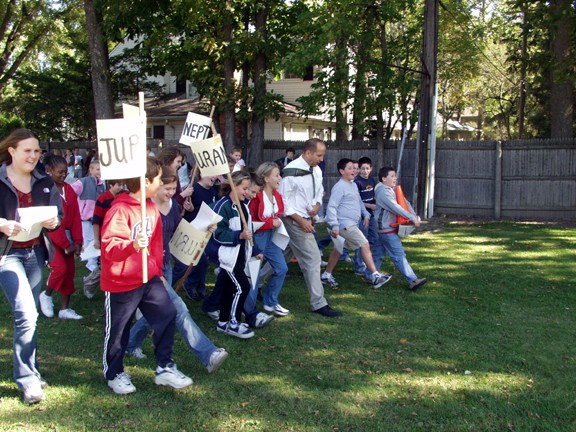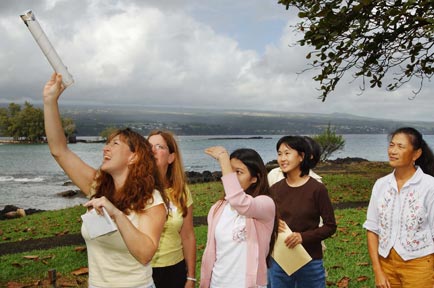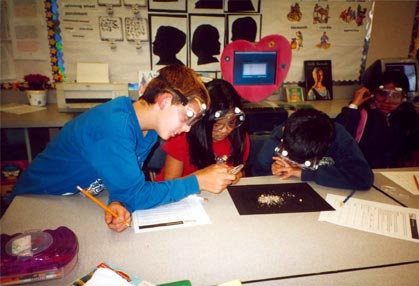All Voyage K-12 lessons can be downloaded from the Journey through the Universe website.
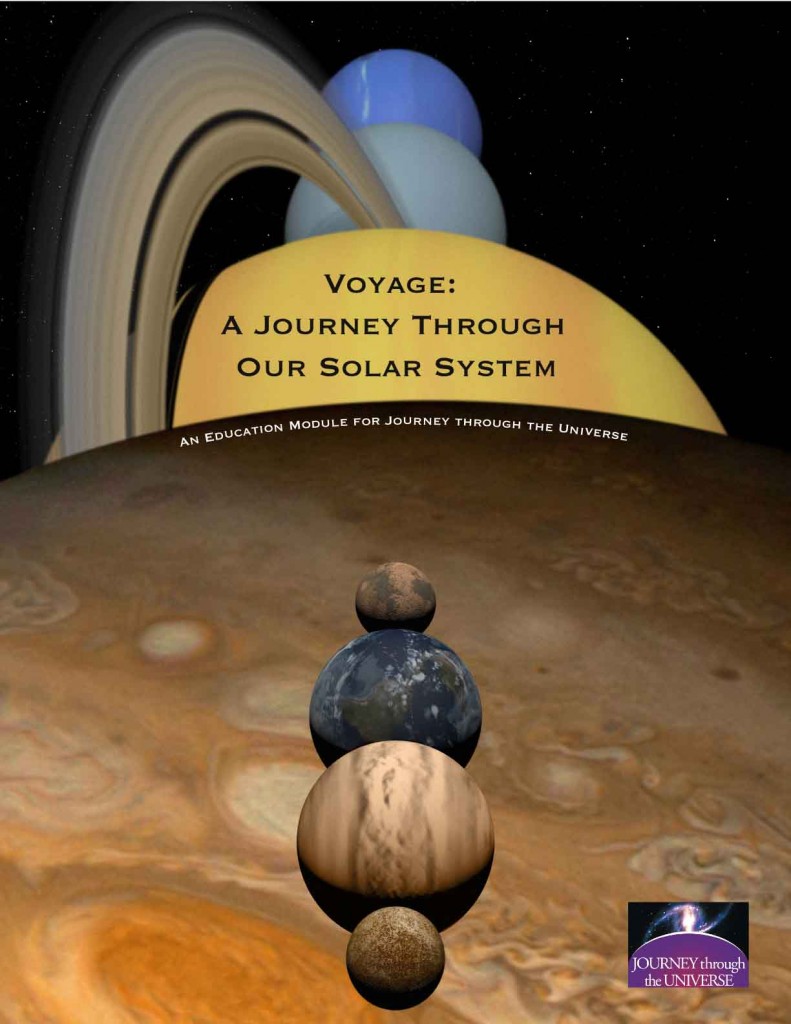 The core objective for the Voyage K-12 Curriculum is to place a visit to a Voyage exhibition within a multi-week classroom unit on Solar System science and exploration. In keeping with the foundational pedagogy for all facets of the Voyage National Program, the Voyage K-12 Curriculum leverages the power of models to develop a conceptual understanding of the inventory, structure, and processes associated with our Solar System.
The core objective for the Voyage K-12 Curriculum is to place a visit to a Voyage exhibition within a multi-week classroom unit on Solar System science and exploration. In keeping with the foundational pedagogy for all facets of the Voyage National Program, the Voyage K-12 Curriculum leverages the power of models to develop a conceptual understanding of the inventory, structure, and processes associated with our Solar System.
The Journey through the Universe initiative also overseen by the National Center for Earth and Space Science Education provides communities a diverse array of programming, including professional development for teachers on content across the Earth and space sciences; family and public programs; and classroom visits by a National Team of researchers. The Voyage Grade K-12 Curriculum is one of five content modules that support Journey through the Universe programing. In this context, professional development for teachers on the Voyage K-12 Curriculum can be provided through Journey through the Universe.
The Voyage Grade K-12 Curriculum includes an Education Unit at four grade levels: lower elementary (K-2); upper elementary (3-4); middle (5-8); and high school (9-12). Due to the concentration on Solar System content that is typical in grades 5-8, a Supplemental Grade 5-8 Education Unit was developed titled The Voyage Continues. Taken together, the grade 5-8 lessons are extensive enough to be adopted as a school district’s curriculum on Solar System science.
The curriculum also includes a home activity so that a family can have a cross-generational learning experience by setting up a temporary Voyage model Solar System in a park, on a beach, or along a long sidewalk.
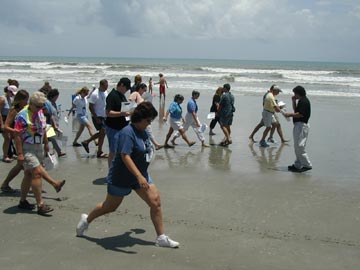
At Kennedy Space Center (KSC) for the August 2, 2004, launch of the MESSENGER spacecraft to the planet Mercury, Fellows of the MESSENGER Educator Fellowship Program (MEFP) are receiving training on the Voyage K-12 Curriculum by Voyage and MEFP Director Dr. Jeff Goldstein. In this photo, on the day before launch, the Fellows are on Cocoa Beach laying out a Voyage scale model Solar System as one of the activities in the Grade 5-8 Voyage of Discovery Lesson. As they arrived at the model Saturn, Jeff noted that the Cassini spacecraft had just entered orbit around the planet a month earlier on July 1, 2004, almost a billion miles from Earth. Looking back north along the beach to the model Sun to understand the incredible distance Cassini had traveled, also in view were KSC’s Vehicle Assembly Building and Space Launch Complex 40 where Cassini had blasted off on its epic journey in 1997. It was a powerful moment, one that the Fellows have shared with thousands of teachers they’ve trained on the Voyage curriculum.
Each Unit contains lessons comprised of content overviews, pre-knowledge assessment, inquiry-based hands-on activities, assessment rubrics, resource listings, student worksheet masters, and answer keys. The lessons were developed from the ground up from national science education standards and benchmarks. Each lesson targets specific core standards and benchmarks and is designed to develop conceptual understanding through activities that seamlessly integrate content and process. Lessons are instructionally designed to support facilitation of inquiry-based learning.
For an understanding of the instructional design template used for each lesson, and the specific objectives for each section of a lesson, download an overview of the Lesson Layout.
More generally, the curriculum content is broad enough for a school district or individual school to map specific lessons to their standards of teaching and learning in Solar System science, and customize a compendium of lessons for use as the district sees fit.
Overviews for the Four Grade-Level Units
Below are PDF files providing the storyline, lesson descriptions, and linkages to national standards for the four grade-level Units.
August 2, 2004, Voyage Grade K-2 Education Unit (PDF, 560 KB)
Voyage Grade 3-4 Education Unit (PDF, 500 KB)
Voyage Grade 5-8 Education Unit (PDF, 600 KB)
Voyage Grade 9-12 Education Unit (PDF, 500 KB)
Summaries of the Voyage Lessons – Lessons are Downloadable from the Curriculum Library
Family and Home Activity: Voyage! (PDF, 500 KB)
Voyage: A Journey Through our Solar System is a one to 10-billion scale model of the Solar System that was permanently installed on the National Mall in Washington, DC, in October 2001, and is being permanently installed in communities worldwide. This activity allows you to create your own Voyage one to 10-billion scale model Solar System, and bring the Voyage experience into your backyard, a nearby park, or your school playground.
Grade K-2 Unit, Lesson 1: Making Models to Understand Our Home (PDF, 580 KB)
Through inquiry and our senses, we discover that our home planet Earth is the largest object we have ever touched. But we occupy such a small part of it that we must make models to see how and where we fit in. Through an “I-Spy” activity, students can learn to recognize common classroom models, and see the value of using models to represent objects that are otherwise difficult to explore. Making simple, two-dimensional models of our own homes, and eventually our neighborhood, helps us begin to understand our world.
Grade K-2 Unit, Lesson 2: A View of Home from the Front Door and from Space (PDF; 570 KB)
The world is full of objects large and small, near and far. Models are built as powerful tools to help study large things such as buildings, towns, countries, and even the Earth and the Moon. With models, things beyond our physical reach can be easily explored. To begin to distinguish “home” from “home planet,” students can build a model of their home and neighborhood as it appears from the front door of the house, from a tall building, from an airplane, and from outer space.
Grade K-2 Unit, Lesson 3: Taking a Voyage Away From Home (PDF; 670 KB)
From common observations of the sky, students understand that the Sun is a star that is close to the Earth, and it appears to go through a daily motion in our sky. By building a dynamic model of the Earth and the Sun—an orrery—students realize that cycles of night and day are caused by a rotating Earth. A puzzle version of Voyage, a scale model of the Solar System, is then constructed to explore the locations of the Sun, Earth and other planets, and to get a sense of the relative sizes of these objects. By combining the two activities, the Solar System is put in motion, reflecting both the objects within the Solar System and their motions.
Grade 3-4 Unit, Lesson 1: Modeling Patterns & Cycles in our Lives (PDF, 590 KB)
Many observable phenomena are associated with predictable cycles and patterns in nature. Sometimes these phenomena are difficult to see, so we build and use models to understand cycles and patterns such as the seasons, the water cycle, or sunrise and sunset. By using the Earth as a prototype, students come to realize that similar patterns and cycles may also exist on other planets.
Grade 3-4 Unit, Lesson 2: Designing a Scale Model of the Solar System (PDF, 620 KB)
Students conduct research on the planets, with emphasis on patterns and cycles, and gain an appreciation for the variation in length of year, length of day, and seasonal variation across the Solar System. To explore whether the patterns and cycles on the planets are related to planetary position in the Solar System, students create posters that can be used to mark the locations of the planets within a Voyage model of the Solar System.
Grade 3-4 Unit, Lesson 3: Voyage Through the Solar System (PDF, 510 KB)
Students build the Voyage scale model of the Solar System on a playground and “travel” to each planet. This exercise allows students to recognize that the Sun and planets are tiny worlds in a vast space. Students also explore the similarities and differences in the patterns and cycles observable on the planets. The students come to realize that while seasonal variation (except for the length of seasons) seems independent of planet location, both the length of the day and length of the year do reflect planetary position. Students then explore why this occurs, with length of year dependent on the distance from the Sun, and length of day dependent on whether the planet is an inner Earth-like planet, an outer Jupiter-like planet, or a Pluto-like object further out in the Solar System. This experience gives students a new perspective on the Solar System, and allows them to gain a new sense of home.
Grade 5-8 Unit, Lesson 1: Our Solar System (PDF, 900 KB)
In this lesson, students tour the Solar System. They examine and define its various components—the Sun, planets, moons, comets, asteroids, and Kuiper Belt Objects. They recognize that the Solar System is the family of the Sun, an average star, and other stars have families of their own. Taking a close look at the planets they find that characteristics like size, location, composition, and presence of rings and moons, reveal two major categories of planets—terrestrial (Earth-like) and Jovian (Jupiter-like). But tiny Pluto seems to be in a class all its own, perhaps the largest of the many ice worlds discovered beyond Neptune.
Grade 5-8 Unit, Lesson 2: Voyage of Discovery (PDF, 870 KB)
Models are powerful tools of exploration, especially as students investigate the size and distance relationships between the Sun and the planets in the Solar System. Examining the relative sizes of the planets using models at a one to ten billion scale, students realize that the Earth, the biggest thing they have ever touched, is quite small in comparison to the Sun and some of the other planets. Moving outdoors, students then create a one to ten billion scale model of the Solar System. Walking through their model as cosmic giants, students are awed by the tiny worlds in a vast space, and gain a new appreciation for Earth, their home.
Grade 5-8 Unit, Lesson 3: How Far is Far? (PDF, 1.3 MB)
Students will determine the actual distance to the Sun and the Moon without ever leaving the Earth, and in doing so will gain a better understanding of the huge distances in the Earth-Sun-Moon system. In order to determine these distances, students will apply their understanding of mathematical models in two different ways, using a single mathematical principle.
Supplemental Grade 5-8 Unit (The Voyage Continues), Lesson 4: Going through a Phase (PDF, 1.1 MB)
The varying appearance of the Moon over the course of a month results from changes in the relative positions of the Earth, Moon, and Sun. In the first Activity, daily observations of the Moon over many weeks allow the phase cycle to be observed and characterized, and an explanation to be hypothesized. The hypothesis is tested in the second Activity where students construct a working model of the Earth-Moon-Sun system and determine if they can recreate the observed phase cycle. To truly develop a conceptual understanding of the phenomenon, students explore whether the Earth should exhibit a phase cycle as seen from the Moon, and whether an Earth observer should see other planets exhibiting phase cycles.
Supplemental Grade 5-8 Unit (The Voyage Continues), Lesson 5: Round and Round We Go – Exploring Orbits in the Solar System (PDF, 900 KB)
To appreciate the complexity of the Solar System requires an understanding that it is a dynamic system—a system in motion. Objects bound to the Sun by gravity—planets, dwarf planets, comets, asteroids, and Trans-neptunian (or Kuiper Belt Objects)—follow elliptical orbits around the Sun. Students first explore the geometric nature of ellipses, and the circle as a special case. These newly developed mathematical skills are then used to plot an accurate model of the outer Solar System, which contains the size, eccentricity, and orientation in space of the orbits for different classes of objects. Students are then able to understand how orbits can be used to help categorize objects in the Solar System.
Supplemental Grade 5-8 Unit (The Voyage Continues), Lesson 6: Where to Look For Life? (PDF, 920 KB)
It is the most exciting question one can ask of the Solar System—is life unique to Earth, or are there abodes of life on other planets—even moons? A starting point is concluding that life as we know it requires liquid water. Given this constraint, in the first Activity students explore a mathematical model for how temperature varies with distance from the Sun. It allows them to find the ‘happy place’ for possible life—the range in distance from the Sun within which a planet might contain liquid water. At first glance, it appears only Earth exists within this range. Students then plot the actual observed temperatures for planets and moons, which demonstrates that more than just distance from the Sun accounts for planetary temperature, leading to potentially many abodes of life in the Solar System. In the second Activity students research the broader requirements for an abode of life, and whether these requirements are found on other worlds.
Supplemental Grade 5-8 Unit (The Voyage Continues), Lesson 7: Is There Anyone Out There? (PDF, 940 KB)
Once scientists have determined where they want to look for life in the Solar System, the next step is to figure out how it is to be done. In this lesson, students first create an operational definition of life, and put it to the test by observing a mystery object. They then define and conduct an experiment, modeled after the life science experiments performed by the Viking Landers on the surface of Mars, to determine if they have discovered life forms in simulated Martian soil samples. The experiment is a simple but dramatic model exploring the differences between chemical and biochemical reactions—which is key to revealing the presence of life.
Supplemental Grade 5-8 Unit (The Voyage Continues), Lesson 8: Comets: Bringers of Life? (PDF, 760 KB)
Comets are an important class of object found in the Solar System. Created at the time of Solar System formation, these “dirty snowballs”—each the size of a city—have remained virtually unchanged for billions of years in the cold outer reaches of the Solar System. Their composition therefore provides clues as to how the Solar System was born, and comet impacts on the early Earth may have been the source of the molecules needed for the formation of life—organic molecules. In the first Activity, students explore the relative abundance of different atoms in the universe, and the molecules that are created from these atoms. In the second Activity, students combine ingredients composed of these molecules to build a good physical model of a comet. The model provides an understanding of cometary composition and structure, and how comets behave when some make a rare trip into the inner Solar System and interact with the Sun.
Supplemental Grade 5-8 Unit (The Voyage Continues), Lesson 9: Asteroids and Meteorites (not currently available)
Asteroids are a class of small rocky and metallic bodies in the Solar System located mostly between the orbits of Mar and Jupiter in the “Asteroid Belt”. They are believed to be remnants of the Solar System’s formation billions of years ago. Meteorites are rocks picked up on the surface of Earth that are known to have arrived from space, and most are believed to be asteroidal debris. The study of asteroids and meteorites therefore provides clues to the formation and evolution of the Solar System.
Supplemental Grade 5-8 Unit (The Voyage Continues), Lesson 10: Impact Craters: A Look at the Past (PDF, 2.6 MB)
The countless craters, big and small, that are found on the surfaces of planets and moons record a violent history of collisions across the entire Solar System. It is a story that spans billions of years. Studies of craters—their shapes, sizes, number in a given area, and whether they are superimposed upon or beneath other geologic features—provide an understanding of how this story may have unfolded. In the first Activity students simulate how impact craters are formed, and how the appearance of a crater depends on the energy of the impacting object. In the second Activity, photographs of the cratered surfaces of other worlds are examined to reveal information about a world’s history, and the history of the entire Solar System.
Grade 9-12 Unit, Lesson 1: A Scale Model Solar System (PDF, 730 KB)
Physical models are powerful tools of exploration. Even simple models can provide enormous understanding about the real objects they represent. In this lesson, students will investigate the properties of scale models of our Solar System. They will then try to design a conveniently-sized scale model of the Solar System to recognize that the model will likely need to be bigger than they thought.
Grade 9-12 Unit, Lesson 2: The Voyage Scale Model Solar System (PDF, 540 KB)
It is challenging to design a scale model of the Solar System where the same scale is used to portray not only the physical sizes of the Sun and planets, but also the distances between them. Planets are tiny worlds in a vast space. In October 2001, the Voyage Scale Model Solar System opened in Washington, DC, displaying a one to ten billion scale of the sizes of the Sun and planets, and the distances between them. In this lesson, students will replicate the Voyage model to experience the size of the Solar System.
Guidance for Printing the Lessons and Assembling a 3-Ring Binder
Lessons should be printed 2-sided. They are instructionally designed for 2-sided use, with navigation graphics that are always on the page on the right side.
There are a few color images in some of the lessons for viewing the PDFs on line. However, all lessons were designed for printing in black and white.
A 3-ring binder with a clear sleeve on the front and on the spine allows color inserts with the Voyage K-12 Curriculum title and graphics. The following can be printed in color and used as the inserts:
Voyage Cover.pdf (1.9 MB)
Voyage Spine.pdf (500 KB)
The 3-ring binder should include an Overview of each Grade-Level Unit printed. These Overviews are downloadable above.
The 3-ring binder should include a copy of the Lesson Layout, which is downloadable above.
If your community is receiving a Journey through the Universe professional development workshop for teachers on the Voyage Grade K-12 Curriculum, then–
- it is important that all attendees have a complete copy of all lessons to be addressed at the workshop
- a workshop may be providing training on some or all of the Grade-Level Units, if so, each Grade-Level Unit of lessons should be assembled as its own section in the 3-ring binder
- workshop attendees will need extra copies of all student worksheets associated with the lessons to be conducted, so they do not write on the master worksheets found in their binders
- copies of both Pre- and Post Workshop Assessment Forms need to be provided to all attendees, and can be inserted in the binder; forms are available from the Center
- other documents to copy for all attendees: Workshop Agenda and Bio(s) of workshop presenter(s), provided by the Center

